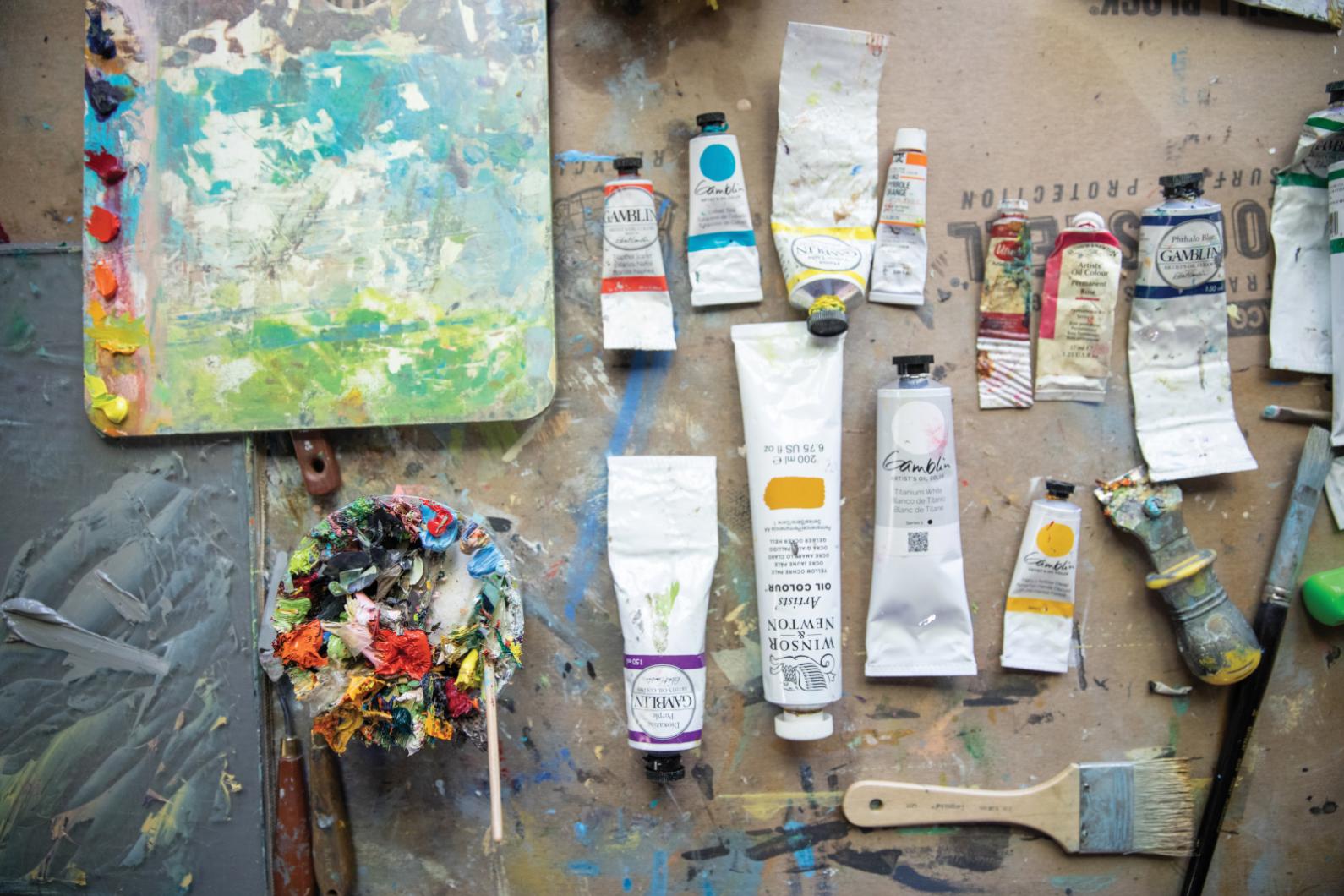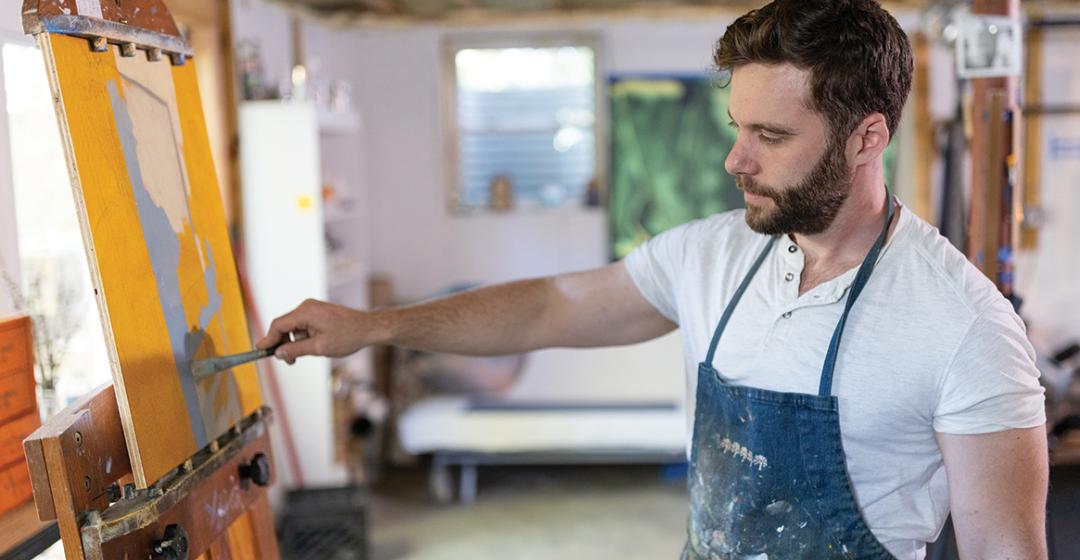On any given day, you might find artist Walker T. Roman sitting on his basement floor in West Tisbury surrounded by tubes of paint and sheets of polymer film, the latter which he has recently been using as a canvas. On this particular day, he scraped acrylic paint mixed with mica powder smoothly over the surface, bringing the cracks and dimples of the concrete seamlessly to light. When the paint had dried, he took scissors to the film, cut it in half, and assembled it back together, deliberately turning the inside out.
Once finished, the painting resembled an iridescent swirl of painted waves in shades of amber. The film created a smooth and satisfying texture, as if the viewer could glide along the painted swoops. He titled the piece Radiolarian, the name for a tiny organism whose skeleton can be found in limestone when it decomposes. Roman, however, was hesitant to describe the painting in more detail.
“I think that when a painting is really successful, or any work of art is really successful, it sets up a series of expectations and then the viewer completes them,” he said.

“I’m trying to bring you to a specific point, but I’m not quite getting there. The way everyone makes that connection is a little bit different…. I think that’s a lot of fun.”
Roman is never not creating. He often displays his work at markets throughout the Island, including the Chilmark Flea and Edgartown Village Market. He is perhaps best known for his Island landscapes: dreamy, colorful vistas depicting steep dunes, the tidal flats of West Basin in Aquinnah, or the Lucy Vincent Beach cliffs in Chilmark, as well as less-saturated winter vistas, including rocks or tidal marshes covered in snow, or a solitary walker bundled up tight against the wind.
But in recent years, Roman has turned his attention to abstract creations. One of his series features shades of gray, white, and black layered and swirled across round canvases. At various points, from different angles, they resemble ice, or stones, or swells of water. They appear hard and soft all at once.
Other abstract works include broad blue strokes or predominately black hues splashed across rectangular canvases.
To create each piece, Roman spends months researching and experimenting with how different combinations of materials, tools, and surfaces interact with one another. Once all his materials are laid out, he tries not to get in the way.

While the abstract work is a stark visual departure from his earlier work, Roman doesn’t think of it as being wholly different from his landscapes.
“I’ve been interested in reading about mythologies and pre-colonial cultures and traditions,” he said. “When you look at very old examples of human creation, there is no distinction between what we now call abstract and what is depicting something real.”
To illustrate his point, Roman called upon examples of ancient cave paintings in France that feature elaborate hunting scenes beside collections of dots and lines, as well as examples of Christ and the Holy Spirit depicted through symbols in medieval art.
He incorporates these elements in his own, decidedly more modern work by mixing elements of nature and chaos. Regardless of the style, he said, every piece is tied to the earth. “If there’s a single thread that ties the two bodies of work together, it’s an intimacy with the natural world and a want to be closer to it. I think that happens in different ways at different times for me.”

The results sometimes surprise him.
“I think a lot about something that a professor of mine, Laurel Sparks, said: ‘If you know what you’re trying to make, why even bother?’”
He’s been wholeheartedly embracing that philosophy ever since.
Before Roman was an accomplished artist, he was a kid living in Oak Bluffs, visiting his friend’s mom’s art gallery, Etherington Fine Art in Vineyard Haven, after school. Even though the gallery closed over a decade ago, Roman remembers marveling at the work of one of the artists, Carrie Mae Smith, who was living on the Island at the time. Her paintings of kitchenware and food appeared effortless, but also directly confronted the viewer, he said. He admired Smith’s use of texture and movement to create a compelling immediacy.

As luck would have it, Roman met Smith a couple of years ago when she returned to the Island and visited his booth at the Chilmark Flea. Smith told him she was familiar with his art. Standing beside the person who made such an impression on his younger self and hearing that she knew about his work was a memory he will never forget. “She was one of the reasons I think I really started looking at paintings,” he said.
If Roman’s childhood interest in art was fostered in Island galleries, it was further nurtured at the Martha’s Vineyard Public Charter School, which he attended from fifth to eighth grade. By the age of twelve, he was borrowing his dad’s old Nikon camera and developing film in the school’s darkroom. Those years were instrumental to his career, he said.
When he was sixteen, he considered giving up art to make music. Ultimately, however, he gave up that dream because he was intimidated by music’s ability to change. He described how each time a singer performs a song, it sounds different. Paintings, on the other hand, freeze a moment in time. Today, he views both music and paintings as having a temporal relationship, and he often uses one to understand the other.
“When we listen to the lyrics of a song, there’s a lot of specificity of story…. That, to me, is a lot like the subject of a painting…. In my mind, abstraction kind of works like just the music – just the notes or the melody where there’s no specific set meaning.”

Following graduation from the Martha’s Vineyard Regional High School in 2008, Roman moved to Boston, where he attended the Massachusetts College of Art and Design. It was his first taste of the art world beyond Vineyard shores. Although the whole experience helped cultivate his artistic skills, one extracurricular experience stood out: visiting the Museum of Fine Arts with a friend.
There, they encountered Philip Guston’s abstract painting, The Deluge (oil on canvas, 77 x 128 inches, 1969). In it, thick, murky, black brushstrokes cover the majority of the canvas. A thinner red strip with caricature-like doodles of a spider, a picture frame, and a clock run across the top.
The two friends were determined to figure out what the painting depicted and refused to leave until it struck them. After twenty minutes, his friend suggested that the canvas was a room being flooded with black water. The doodles, he posited, represented objects hanging on the walls.
Roman found himself drawn to this explanation and the search for meaning. “Maybe that’s why I find myself flipping back and forth between figuration and abstraction,” he offered.

The painting has continued to influence Roman’s recent work in subtle, unconscious ways. In his series “Shadow of the Mountain,” for example, he mixed black acrylic paint with resin until it had a rough, clay-like texture. He then scraped the paint over polymer film and burnished the surface with powdered graphite, resulting in an all-consuming and fearsome feeling, similar to rising water.
While Roman’s abstract art may be reminiscent of heavy, dark strokes, his current life seems anything but. Today, he lives in West Tisbury with his wife, Danielle Mulcahy. The pair married in 2021 and share their space with a miniature horse named Sugar, a pony named Larry, too many chickens to name, and two cats – Umi, who often sits on Roman’s shoulder while he paints, and Titi. Mulcahy also has a studio at home, where she paints and takes photos for her business, Archil Designs, which celebrates old art forms in textiles.
The couple first met at art school in Boston. From the moment he saw her, Roman said, he knew Mulcahy was special. Over time, the two became rivals, trying to one-up each other with their pieces. During senior year, they realized their passion could be something more than competition and started to date. “We joke that it’s always best to keep your enemies closer,” Roman said.
Two years after their engagement in 2014, they renovated a travel trailer, packed what they needed, and set off. They spent the next year living out of the vehicle and traveling all over the United States. They painted everywhere they went – from the woods of Oregon to the deserts of Texas, the red rocks of Utah and the mountains of Colorado.

Living in such a tight space forced Roman to explore other mediums. He began using watercolors because the palettes were small and portable.
“Taking our personal lives, but also both of our artistic lives, and shrinking them down so they fit into a twenty-six-foot trailer was pretty challenging,” he said. “Making big paintings is hard living
in a trailer.”
Though Roman hasn’t continued to work with watercolors, the medium did influence his future work. As did the trip itself. He learned that he needs to be surrounded by new inspiration, he said. “As important as it is having art be close to where I live, I think it’s as important for me to leave and go and experience other places.”
Still, of all the places he’s visited, he said, none were quite as magical as the island he calls home.

In January, Roman will leave the Vineyard for an artist residency at the Aviário Studio in Portugal, where he will focus on his drawing and printmaking. He’ll spend dedicated periods of time working within specific constraints, exploring what he can create with ink and paper. In March, he will take part in another artist residency that focuses on light and color at the Vermont Studio Center.
“It’s like picking up an instrument that you haven’t played in a long time and seeing what’s changed in me since I did this last,” he said. “How does my understanding of those sensibilities change in this new context?”
But before long, the Island’s lively waters and thick forests will beckon him home. He’ll bring back fresh ideas, inspiration, and new pieces to share with Vineyard markets and galleries.
While he doesn’t know what the pieces will look like yet, he does know they will reflect his authentic self. Each stroke of his brush will contain memories of the journeys he made and the obstacles he faced. They’ll also include many unknowns.





